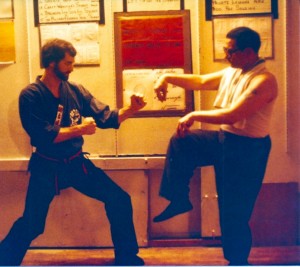MMA – Il Buono, il Brutto, e il Cattivo – Parte 2
L’articolo seguente (Parte 2 di 2 parti ) è stato ispirato da una serie di commenti scritti su un mio post da un istruttore cintura nera che ha studiato prima con uno dei miei allievi diretti e poi ha ampliato la sua esperienza studiando Brazilian Jiu-jitsu. Ho leggermente modificato alcuni dei brani, per condividere i contenuti della nostra discussione con tutti i lettori.
L’istruttore mi raccontava le sfide che aveva dovuto affrontare quando aveva tentato di aggiungere un programma di MMA al suo curriculum, e il suo conseguente e notevole grado di insoddisfazione. Potete trovare le sue osservazioni originali scritte sotto il mio precedente articolo dal titolo “Tradizione vs MMA – Parte 4“.
Nelle sue osservazioni, il mio studente di seconda generazione, include anche la “lezione” non proprio positiva che aveva imparato da questa storia. La Parte 2 di questa serie, scritta qui sotto, e’ la continuazione delle mie risposte e rimane in contesto con i suoi commenti..
RIFLESSIONI
Molti anni fa, come giovane Sensei e molto prima che le MMA diventassero così popolari, feci alcuni errori simili a quelli lamentati dall’allievo del mio studente nella Parte 1 di questa serie. In un tentativo sincero di rimuovere ciò che scambiavo per “egoismo” dal mio insegnamento, iniziai a modificare un po’ la struttura formale nel mio dojo e a sostituire me stesso con un’immagine simile a quella di un “coach” di una “palestra”.
Diventai permissivo con il protocollo del dojo, sullo scambio di cortesie (inchino, ecc) cominciammo a chiamarci per nome socializzando anche al di fuori del dojo più come “pari”. Non dovette passare molto tempo prima che mi rendessi conto cosa voleva dire sfocare le linee, non separando studente e Maestro, in particolare, quella della responsabilità “dell’esempio” che ogni leader forte o mentore deve dare ed essere per non diventare come “uno dei ragazzi”. (more…)
MMA – The Good, the Bad, and the Ugly – Part 2
The following article (Part 2 of a 2 part series) was inspired by a number of comments posted by a serious Black Belt instructor who studied with one of my direct students and then expanded the ground aspect of his own MA experience by studying Brazilian Jiu-jitsu. I have slightly modified some of the excerpts from my responding comments in order to share the content of our discussion with our general readers.
This instructor explained the challenges he endured when he attempted to add an MMA program to his curriculum, subsequently resulting in a significant degree of dissatisfaction. You can find his original comments written at the end of my previous article titled, “MMA vs. Tradition – Part 4“.
In these comments submitted by my second generation student, he included the “lessons” he had learned from not so positive experience. Part 2 of this series, written below, is a continuation of my responses and remains in context with his comments.
REFLECTIONS
Many years ago, as a young Sensei and long before the recent MMA popularity, I also made some mistakes similar to those lamented by my student’s student in Part 1 of this series. In a sincere attempt to remove what I mistook for “egoism” from my teaching I began to replace the somewhat formal structure in my dojo and began to run it more like a “coach” in a “gym”.
I became lax with dojo protocol such as exchanging courtesies (bowing, etc.) We called each other by first name and even socialized outside the dojo more like “peers”. It wasn’t until much later that I realized how significantly this began “blurring the lines” separating student and Master teacher, particularly, the responsibility to “set the example” that any strong leader and/or mentor must do and not allow himself to become “one of the boys”. (more…)
